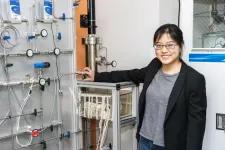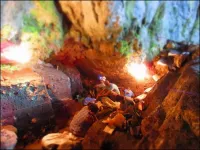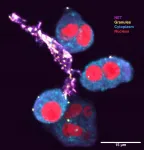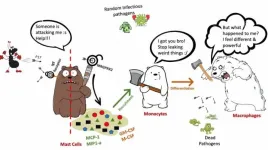(Press-News.org) Pure quantum systems can undergo phase transitions analogous to the classical phase transition between the liquid and gaseous states of water. At the quantum level, however, the particle spins in states that emerge from phase transitions display collective entangled behavior. This unexpected observation offers a new avenue for the production of materials with topological properties that are useful in spintronics applications and quantum computing.
The discovery was made by an international collaboration led by Julio Larrea, a professor at the University of São Paulo's Physics Institute (IF-USP) in Brazil. Larrea is first author of an article on the study published in Nature. The research was supported by FAPESP.
"We obtained the first experimental evidence of a first-order quantum phase transition in a quasi-two-dimensional system consisting entirely of spins. It was a groundbreaking study in terms of both experimental development and theoretical interpretation," Larrea said.
To understand the significance of this discovery, it will help to examine the classical phase transition, which can be exemplified by the change in the state of water, and its quantum analogue, exemplified by the Mott metal-insulator transition.
"The change in the state of water, which occurs at 100 °C under standard atmospheric pressure, is what we call a first-order transition. It is characterized by a discontinuous jump in molecule density. In other words, the number of water molecules per unit volume varies drastically between one state and the other," Larrea said. "This first-order discontinuous transition evolves in accordance with pressure and temperature until it is fully suppressed at the so-called critical point of water, which occurs at 374 °C and 221 bar. At the critical point, the transition is second-order, i.e. continuous."
In the vicinity of the critical point, the properties of water behave anomalously, because the density fluctuations are infinitely correlated on the atomic length scale. As a result, the material manifests a unique state that differs both from a gas and a liquid (see Figure 1).
"In quantum matter, the Mott metal-insulator transition is a rare example of a first-order transition. Unlike ordinary metals and insulators, which have free electrons that don't interact, a Mott state involves strong interaction between electron charges, configuring collective behavior," Larrea explained. "The energy scales of these interactions are very low, so a first-order quantum phase transition between a metal and an insulator can happen at absolute zero, which is the lowest possible temperature. The interaction between charges varies with temperature and pressure until it is suppressed at the critical point. As the critical point approaches, volume charge density, which is the quantity of charge per unit volume, undergoes such an abrupt change that it can induce new states of matter such as superconductivity."
In the two examples mentioned, the phenomena involve massive particles such as water molecules and electrons. The question posed by the researchers was whether the concept of phase transition could be extended to massless quantum systems, such as a system made up solely of spins (understood as a quantum manifestation of matter associated with magnetic states). A situation of this kind had never been observed before.
"The material we used was a frustrated quantum antiferromagnet SrCu2(BO3)2," Larrea said. "We measured the specific heat of small samples under simultaneously extreme conditions of temperature [to 0.1 kelvin], pressure [to 27 kilobar] and magnetic field [to 9 tesla]. Specific heat is a physical property that gives us a measure of the internal energy in the system, and from this, we can infer different types of orderly or disorderly quantum state, and possible electronic states or entangled spin states."
Obtaining these measurements with the precision required to reveal correlated quantum states, using samples submitted to extremely low temperatures, high pressures and strong magnetic fields, was a formidable experimental challenge, according to Larrea. The experiments were performed in Lausanne, Switzerland, at the Laboratory for Quantum Magnetism of the Federal Polytechnic School of Lausanne (LQM-EPFL), headed by Henrik Rønnow. The precision of the measurements motivated the theoretical collaborators, led by Frédéric Mila (EPFL) and Philippe Corboz (University of Amsterdam), to develop state-of-the-art computational methods with which to interpret the different anomalies observed.
"Our results showed unexpected manifestations of quantum phase transitions in pure spin systems," Larrea said. "First, we observed a quantum phase transition between two different kinds of entangled spin state, the dimer state [spins correlated at two atomic sites] and the plaquette state [spins correlated at four atomic sites]. This first-order transition ends at the critical point, at a temperature of 3.3 kelvin and pressure of 20 kilobar. Although the critical points of water and the SrCu2(BO3)2 spin system have similar characteristics, the states that emerge near the critical point of the spin system comply with a different description of physics, of the Ising type." The term Ising refers to a model of statistical mechanics named for German physicist Ernst Ising (1900-98).
"We also observed that this critical point has a discontinuity in magnetic particle density, with triplets or states correlated in different configurations of spin orientation, leading to the emergence of a purely quantum antiferromagnetic state," Larrea said (see Figure 2).
The next step for Larrea is to find out more about the criticality and entangled spin states that emerge in the vicinity of the critical point, the nature of the discontinuous and continuous quantum phase transitions, and the energy scales that represent the interactions and correlations between electron spins and charges leading to quantum states such as superconductivity. "To this end, we plan to conduct a study with pressures around the critical point and higher pressures," he said. A new facility, the Laboratory for Quantum Matter under Extreme Conditions (LQMEC), is being set up for this purpose in collaboration with Valentina Martelli, a professor in IF-USP's Department of Experimental Physics.
INFORMATION:
About São Paulo Research Foundation (FAPESP)
The São Paulo Research Foundation (FAPESP) is a public institution with the mission of supporting scientific research in all fields of knowledge by awarding scholarships, fellowships and grants to investigators linked with higher education and research institutions in the State of São Paulo, Brazil. FAPESP is aware that the very best research can only be done by working with the best researchers internationally. Therefore, it has established partnerships with funding agencies, higher education, private companies, and research organizations in other countries known for the quality of their research and has been encouraging scientists funded by its grants to further develop their international collaboration. You can learn more about FAPESP at http://www.fapesp.br/en and visit FAPESP news agency at http://www.agencia.fapesp.br/en to keep updated with the latest scientific breakthroughs FAPESP helps achieve through its many programs, awards and research centers. You may also subscribe to FAPESP news agency at http://agencia.fapesp.br/subscribe.
DURHAM, N.C. -- You know your dog gets your gist when you point and say "go find the ball" and he scampers right to it.
This knack for understanding human gestures may seem unremarkable, but it's a complex cognitive ability that is rare in the animal kingdom. Our closest relatives, the chimpanzees, can't do it. And the dogs' closest relative, the wolf, can't either, according to a new Duke University-led study published July 12 in the journal Current Biology.
More than 14,000 years of hanging out with us has done a curious thing to the minds of dogs. They have what are known as "theory of mind" abilities, or mental skills allowing them to infer what humans are thinking and feeling in some situations.
The study, a comparison of 44 ...
Astronomers have made the rare sighting of two stars spiralling to their doom by spotting the tell-tale signs of a teardrop-shaped star.
The tragic shape is caused by a massive nearby white dwarf distorting the star with its intense gravity, which will also be the catalyst for an eventual supernova that will consume both. Found by an international team of astronomers and astrophysicists led by the University of Warwick, it is one of only very small number of star systems that has been discovered that will one day see a white dwarf star reignite its core.
New research published by the team today (12 July) in Nature Astronomy confirms that the two stars are ...
Researchers from the Buck Institute and Stanford University have created an inflammatory clock of aging (iAge) which measures inflammatory load and predicts multi-morbidity, frailty, immune health, cardiovascular aging and is also associated with exceptional longevity in centenarians. Utilizing deep learning, a form of AI, in studies of the blood immunome of 1001 people, researchers also identified a modifiable chemokine associated with cardiac aging which can be used for early detection of age-related pathology and provides a target for interventions. Results are published in Nature Aging.
"Standard immune metrics which can be used to identify individuals most at risk for developing single or even multiple chronic diseases ...
According to the study, Australia, Indonesia and the USA provide the largest carbon storage potential with their coastal ecosystems. The team also calculated which countries benefit most from the coastal CO2 uptake worldwide. The different ways in which countries are affected by climate change are quantified by using the so-called social costs of carbon.
"If we take into account the differences in marginal climate damages that occur in each country, we find that Australia and Indonesia are clearly the largest donors in terms of globally avoided climate damages originating from coastal CO2 uptake, as they themselves derive comparatively little benefit ...
Many exoplanets have opaque atmospheres, obscured by clouds or hazes that make it hard for astronomers to characterize their chemical compositions. A new study shows that haze particles produced under different conditions have a wide range of properties that can determine how clear or hazy a planet's atmosphere is likely to be.
Photochemical reactions in the atmospheres of temperate exoplanets lead to the formation of small organic haze particles. Large amounts of these photochemical hazes form in Earth's atmosphere every day, yet our planet has relatively clear skies. The reason has to do with how ...
A diet rich in fermented foods enhances the diversity of gut microbes and decreases molecular signs of inflammation, according to researchers at the Stanford School of Medicine.
In a clinical trial, 36 healthy adults were randomly assigned to a 10-week diet that included either fermented or high-fiber foods. The two diets resulted in different effects on the gut microbiome and the immune system.
Eating foods such as yogurt, kefir, fermented cottage cheese, kimchi and other fermented vegetables, vegetable brine drinks, and kombucha tea led to an increase in overall microbial diversity, with stronger effects from larger servings. ...
You're as old as your immune system.
Investigators at the Stanford University School of Medicine and the Buck Institute for Research on Aging have built an inflammatory-aging clock that's more accurate than the number of candles on your birthday cake in predicting how strong your immune system is, how soon you'll become frail or whether you have unseen cardiovascular problems that could become clinical headaches a few years down the road.
In the process, the scientists fingered a bloodborne substance whose abundance may accelerate cardiovascular aging.
The story of the clock's creation will be published July 12 in Nature Aging.
"Every year, the calendar tells us we're a year older," said David ...
The cave of Satsurblia was inhabited by humans in different periods of the Paleolithic: Up to date a single human individual dated from 15,000 years ago has been sequenced from that site. No other human remains have been discovered in the older layers of the cave.
The innovative approach used by the international team led by Prof. Ron Pinhasi and Pere Gelabert with Susanna Sawyer of the University of Vienna in collaboration with Pontus Skoglund and Anders Bergström of the Francis Crick Institute in London permits the identification of DNA in samples of environmental ...
Boosting the body's own disease-fighting immune pathway could provide answers in the desperate search for new treatments for tuberculosis.
Tuberculosis still represents an enormous global disease burden and is one of the top 10 causes of death worldwide.
Led by WEHI's Dr Michael Stutz and Professor Marc Pellegrini and published in Immunity, the study uncovered how cells infected with tuberculosis bacteria can die, and that using new medicines to enhance particular forms of cell death decreased the severity of the disease in a preclinical model.
At a glance
Researchers were able to demonstrate that cells infected with tuberculosis bacteria have functional ...
Ants are omnipresent, and we often get blisters after an ant bite. But do you know the molecular mechanism behind it? A research team led by Professor Billy K C CHOW from the Research Division for Molecular and Cell Biology, Faculty of Science, the University of Hong Kong (HKU), in collaboration with Dr Jerome LEPRINCE from The Institut national de la santé et de la recherche médicale (INSERM) and Professor Michel TREILHOU from the Institut National Universitaire Champollion in France, have identified and demonstrated a novel small peptide isolated from the ant venom can initiate an immune pathway via a pseudo-allergic receptor MRGPRX2. The study ...






